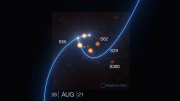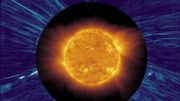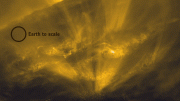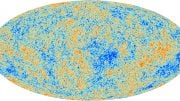
The Sun’s magnetic fields are responsible for our star’s long-term brightness variations. At its surface, they become noticeable in the form of dark regions, so-called sunspots. Credit: NASA/SDO
For the first time, researchers reconstruct and detail the two phenomena that are responsible for the fluctuation of brightness in our sun.
The Sun shines from the heavens, seemingly calm and unvarying. In fact, it doesn’t always shine with uniform brightness, but shows dimmings and brightenings. Two phenomena alone are responsible for these fluctuations: the magnetic fields on the visible surface and gigantic plasma currents, bubbling up from the star’s interior. A team headed by the Max Planck Institute for Solar System Research in Göttingen reports this result in today’s issue of Nature Astronomy. For the first time, the scientists have managed to reconstruct fluctuations in brightness on all time scales observed to date – from minutes up to decades. These new insights are not only important for climate research, but can also be applied to distant stars. And they may simplify the future search for exoplanets.

The flows of hot plasma within the Sun create a characteristic pattern on its surface: the granulation. Bright and darker regions within this pattern change quickly. The granulation is mainly responsible for the Sun’s brightness variations that occur within less than five hours. This image of the granulation was taken in 2009 by the instrument IMaX on board the balloon-borne solar observatory Sunrise. Credit: MPS
When an exoplanet transits in front of its parent star, the star darkens briefly. Even from a distance of many light-years, space telescopes register these changes – and thus detect the exoplanets. In theory. In practice, it’s more complicated, as the brightness of many stars fluctuates, similar to that of the Sun.
These fluctuations can overlay the signals of passing exoplanets. “However, if we are aware of the details of the star’s intrinsic brightness fluctuations, exoplanets can be detected with great precision,” says Alexander Shapiro of the Max Planck Institute for Solar System Research.
Shapiro and his colleagues have taken a first step in this direction with their current paper – with a detailed look at a special star: our Sun. Since the beginning of the space age, numerous spacecraft have delivered detailed data collected unaffected by the disturbances caused by the Earth’s atmosphere.
These data seriously challenge any model describing fluctuations in stellar brightness: can the measured fluctuations be reconstructed using a model? And is it possible to link the fluctuations to the physical properties of the star?
One particular difficulty: the brightness of our Sun varies on very different time scales. Some fluctuations have cycles of only a few minutes; others, which have an impact on Earth’s long-term climate, can only be recorded by researchers over decades. A unified theory encompassing all of these time scales has so far been lacking.
The new study’s tour de force lies exactly in this point. It proves that only two phenomena determine how bright our star shines. On the one hand, are the hot plasma currents rising from the interior of the Sun, cooling and sinking again into its depths. The hot, ascending material is brighter than the plasma that has already cooled on the surface.
In this way, the currents generate a characteristic, rapidly changing pattern of light and dark areas, known as granulation. Typical structures within this granulation are several hundred kilometers in size. “Granulation primarily causes rapid brightness fluctuations, with time scales of less than five hours,” says Max Planck researcher and co-author Natalie Krivova.
On the other hand, the Sun’s variable magnetic fields play a decisive role. During periods of high activity, they can be recognized on the visible surface of our star by way of dark regions (sunspots) and especially bright areas (faculae). Compared to granulation, both structures are very large; some sunspots can even be discerned with the naked eye from Earth. In addition, variations in their number and form are considerably slower. Changes in the Sun’s magnetic field, therefore, lead to brightness fluctuations across time scales of more than five hours.
For their analyses, the researchers employed data obtained from instruments on the SOHO (Solar and Heliospheric Observatory) and SDO (Solar Dynamics Observatory) space probes, which have been recording the brightness patterns and the magnetic fields on the surface of the Sun for years. Using these records, some of which cover a 19-year period of solar development, they were able to analyze brightness fluctuations and in turn compare them with measured data obtained from PICARD and SOHO (obtained by another instrument than recorded the magnetic field).
All previously measured brightness fluctuations – both rapid and very long-term – can be reproduced in this way. “The results of our study show us that we have identified the governing parameters in our model,” concludes Sami K. Solanki, Director at the Max Planck Institute for Solar System Research and second author of the study. “This will now allow us, finally, to model the brightness fluctuations of other stars.”
Reference: “Nature of solar brightness variations” by A.I. Shapiro, S.K. Solanki, N.A. Krivova, R.H. Cameron, K.L. Yeo, W.K. Schmutz, 21 August 2017, Nature Astronomy.
DOI: 10.1038/s41550-017-0217-y









Be the first to comment on "Astronomers Detail the Nature of Solar Brightness Variations"